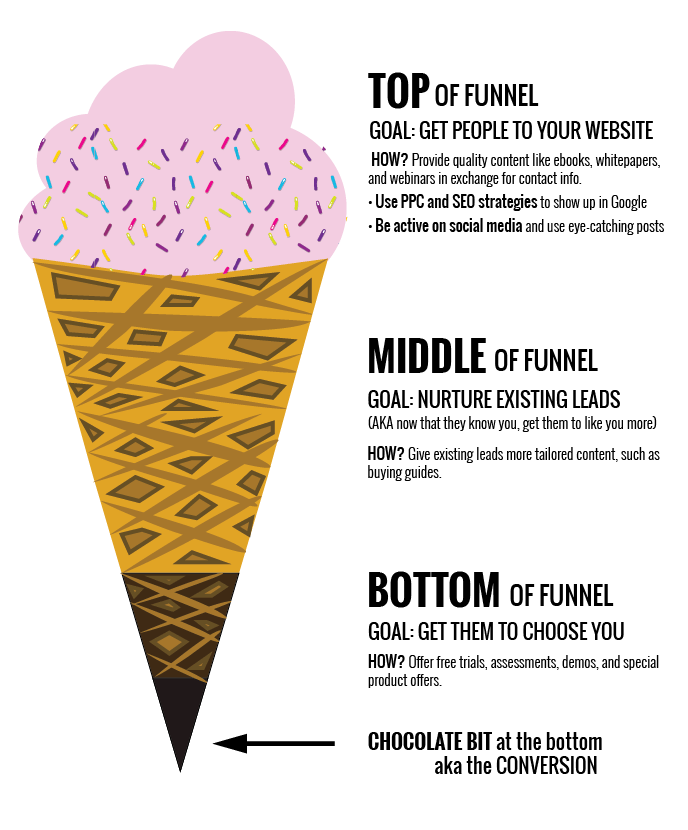You may not have considered this as the first part of your customer journey but it all starts with a potential customer learning that you even exist. If you’re only focusing on improving communication with people who enquire, you’re already missing out on opportunities.
You’ll probably have heard of the sales funnel – at each stage of the sales process a percentage of your prospects will move closer to purchasing with others dropping out along the way. Making the most of your first interaction with a potential customer ensures you fill the start of your sales funnel with the greatest number of potential leads. You want to increase the conversion rate of those that see you exist, to those that look a bit further.
So, what do we mean about learning you exist. Let’s focus on how the customer first hears about you and how you’re presenting yourself to them.

How does my company look when I’m found online?
Your customer could find you:
- In Google results
- On a business directory
- On a lead generation site
- Through a recommendation (let’s say this is on social media and then they go onto your profiles)
These are all a first touch point with your business. But when was the last time you looked at your first points of contact, what they look like to the customer and how you fair against your competition?
Search Engine Results:
Let’s take your your listing on Google when someone types in ‘Building Survey Near Me’. Does your result just have your company name and generic information about how long you’ve been in business listed in the blurb or does your listing make your offering extremely clear? For example:

The result doesn’t mention the survey type and looks quite boring. It immediately looks less relevant than other results and makes me feel like I’m taking a chance that my click could be worthwhile or time wasted.

This result makes it clear you offer the survey they need, where you cover and provides a clear call to action to get people onto your website. Make your listing obvious and more people are likely to click on your listing.
I’m not suggesting that the latter option is the perfect copy to use. But hopefully you get my point that it is certainly going to grab more attention than the listing on the left.
One side note which we’ll cover in the future in much more detail: the more your web page and your listing (also known as the meta description and meta title shown in the above example) mention the keywords and phrases your customers type in to Google, the more relevant Google will realise you are to a customers search and the more likely it is that you move up the Google rankings. You can create pages on your website for each survey type you offer and get these to rank on Google for specific searches rather than just hoping your homepage will answer every search query for every customer. We will cover this topic in more detail in a future post but feel free to drop us a call if you want to discuss getting more from your website before then.

Lead-Gen Sites / Business Directories
The same principal goes for your listing on a lead-generation site. When you come up in the results, it doesn’t matter where you appear (cheapest or most expensive). We all know customers will pay more for a product or service if they understand the value it offers (look at Waitrose). Make sure you review your profile versus your competition to see how well you engage a customer.
What does the customer want to find out in your profile to make them click on your website link?
They want to know:
- Do you offer the service they need?
- Do you cover the right location?
- Why are you worth considering?
And I don’t mean stating the obvious like I have ‘x’ many years experience doing surveys so I charge twice the price. Instead make it clear!
“We understand that you are getting a survey to make sure that when you buy your property, you can move in with full peace of mind. To make sure we can offer you only the best advice we spend twice as long inspecting your property as the average surveyor and we carry specialist tools with us that are not used by many others. We do this to ensure we can pin point every issue in a property and its exact cause. This allows us to provide you a report and advice that tells you exactly what you need to know and what you’ll need do… not just a list of potential avenues you’ll need to explore next. Our report will provide you a simple breakdown of all our findings with videos and pictures outlining exactly what we are talking about. We do this to give you confidence in your purchase or the ability to engage with the vendor more easily should there be anything you need to discuss. We include a free consultation once you have our report to answer any questions and help you with your next steps.”
OR
“We are Chartered Surveyors regulated by the RICS. We have carried out many types of survey for over 30 years. Here is a video by RICS about the different survey types you can choose between. Look at this table to see the difference between our surveys”
The second one is surprisingly common (albeit longer) but tells the customer nothing different to any other surveyor (other than how long you’ve been a surveyor). If every surveyor offers the same generic information about how reports differ and what a RICS survey is, of course they won’t understand why prices differ. If you go to a supermarket shelf and see two similar items, both appear the same and one is much cheaper, which do you choose? So what makes you different to the surveyor charging half the price? If you’re profile or website doesn’t explain that the customer has got no reason to contact you.
To add to this, consider this – a lack of clarity in explaining your proposition provides a subtle suggestion into the lack of clarity that will come in a report (at least from the customers perspective). Knowing how to sell yourself and how to inspect a property are two different skills. But in the customers mind, knowing how to explain something to them is required in both. It’s a subconscious red flag.
Your Website
Congratulations – you’ve got some web traffic. Here’s what you need to consider next:
- How well does your website load? If it is slow, you’ve just lost some of your traffic before they’ve even seen how it looks. Increase the amount of traffic that even reads your page by making sure it is fast to load on desktop and mobile. Why? Because 53% of mobile site visits are abandoned if pages take longer than 3 seconds to load (Doubleclick). This is similar for desktop.

- How does it look? If you’ve ever walked down the high street, you’ll always be drawn into a new, modern looking shop. Most people will avoid the shop that’s looking tired and outdated. It just suggests you aren’t doing very well. An outdated website says exactly the same thing. More importantly online it also signals the website isn’t very secure resulting in very few people being willing to fill out a contact or quote form.
- How easy is it to find information? Each landing page (the pages you get to after clicking on any of your results on Google) needs to be immediately clear about what you are talking about. If I land on a page about Building Surveys, it should immediately discuss which properties that survey it is suited to, why it is different to other surveys and what makes your Building Survey report better than anyone else’s. If that’s clear, where do I click next to get a quote or enquire further? A clear call to action button (or several) – on the page telling the customer what to do next will increase the chances they take that next step.
- Clear call to action: if the information is clear, easy to find and nicely displayed then how clear is it what next step I should take? Relying on a customer to use your menu bar to go to the contact page is a weak call to action. Your page should have one or several call to action buttons placed strategically on the page enticing a potential customer to take whatever next step you want – get a quote, fill in a form, compare to another survey type and so on.
Summary:
- Review your online listings (or leaflets in estate agents) and consider how clear they show your unique proposition
- Make sure your website is simple, jargon free and is easy to navigate
- Provide clear call to action buttons that encourage potential customers to make that all important enquiry
